Social Policy, Health and Welfare: Aboriginal Community Health Report
VerifiedAdded on 2022/08/20
|8
|2239
|18
Report
AI Summary
This report examines the complex interplay of social policy, health, and welfare within Aboriginal communities in Australia, focusing on the disproportionate impact of social determinants of health on conditions like hypertension, diabetes, and cardiovascular diseases. It highlights the importance of culturally competent healthcare delivery, community needs assessments, and social interventions. The report synthesizes findings from various studies, including those by Larkins et al., Daly et al., Campbell et al., and Sibthorpe et al., to analyze risk factors, community-controlled health services, and the impacts of continuous quality improvement. Key themes include the influence of socioeconomic factors, family history, psychosocial habits, and the crucial role of education, access to healthcare, and community engagement in addressing health disparities. The report emphasizes the necessity of tailored policies, collaboration between healthcare providers, community leaders, and the importance of addressing the social, clinical, and psychosocial needs of the Aboriginal community to improve health outcomes and promote well-being.
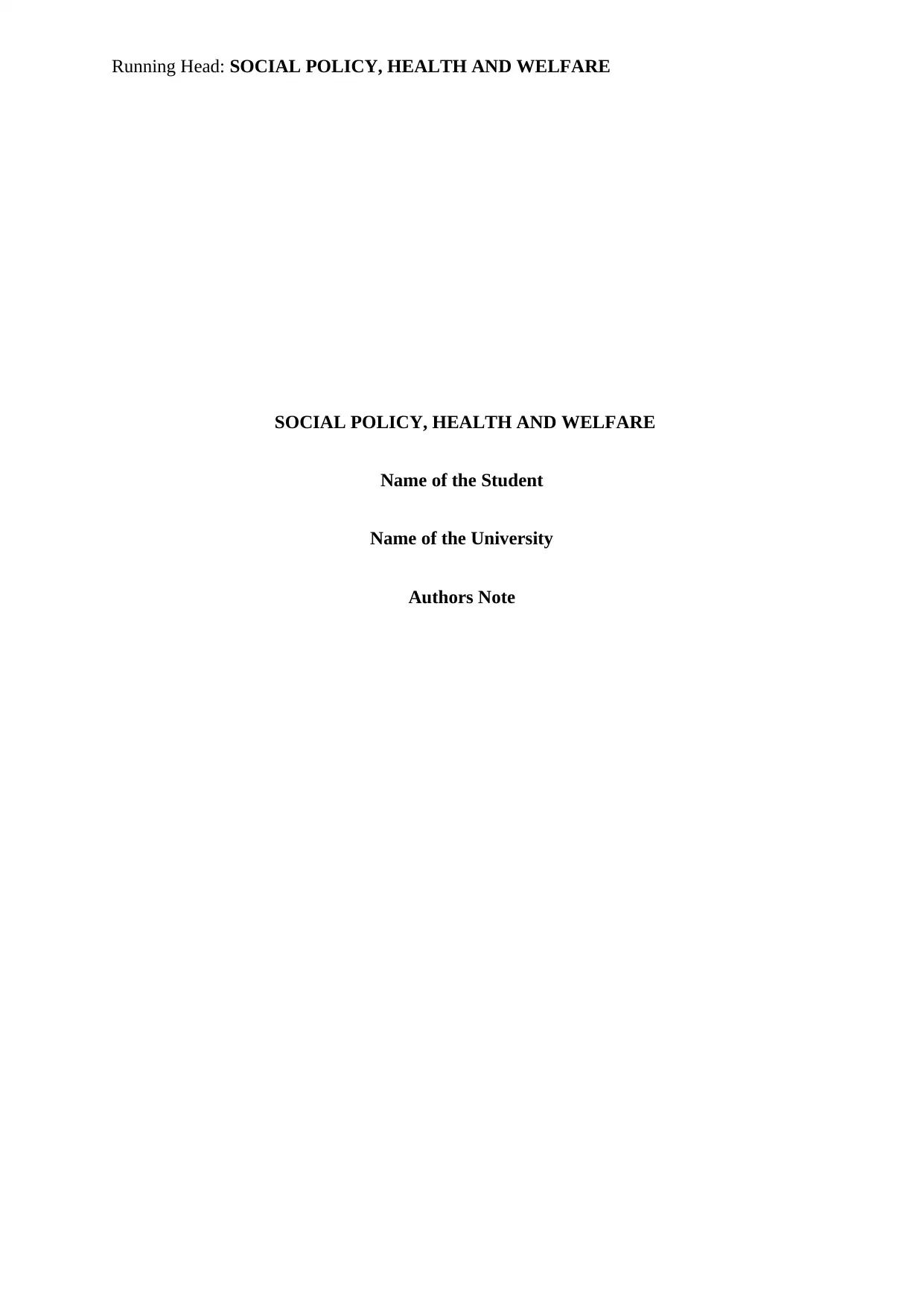
Running Head: SOCIAL POLICY, HEALTH AND WELFARE
SOCIAL POLICY, HEALTH AND WELFARE
Name of the Student
Name of the University
Authors Note
SOCIAL POLICY, HEALTH AND WELFARE
Name of the Student
Name of the University
Authors Note
Paraphrase This Document
Need a fresh take? Get an instant paraphrase of this document with our AI Paraphraser
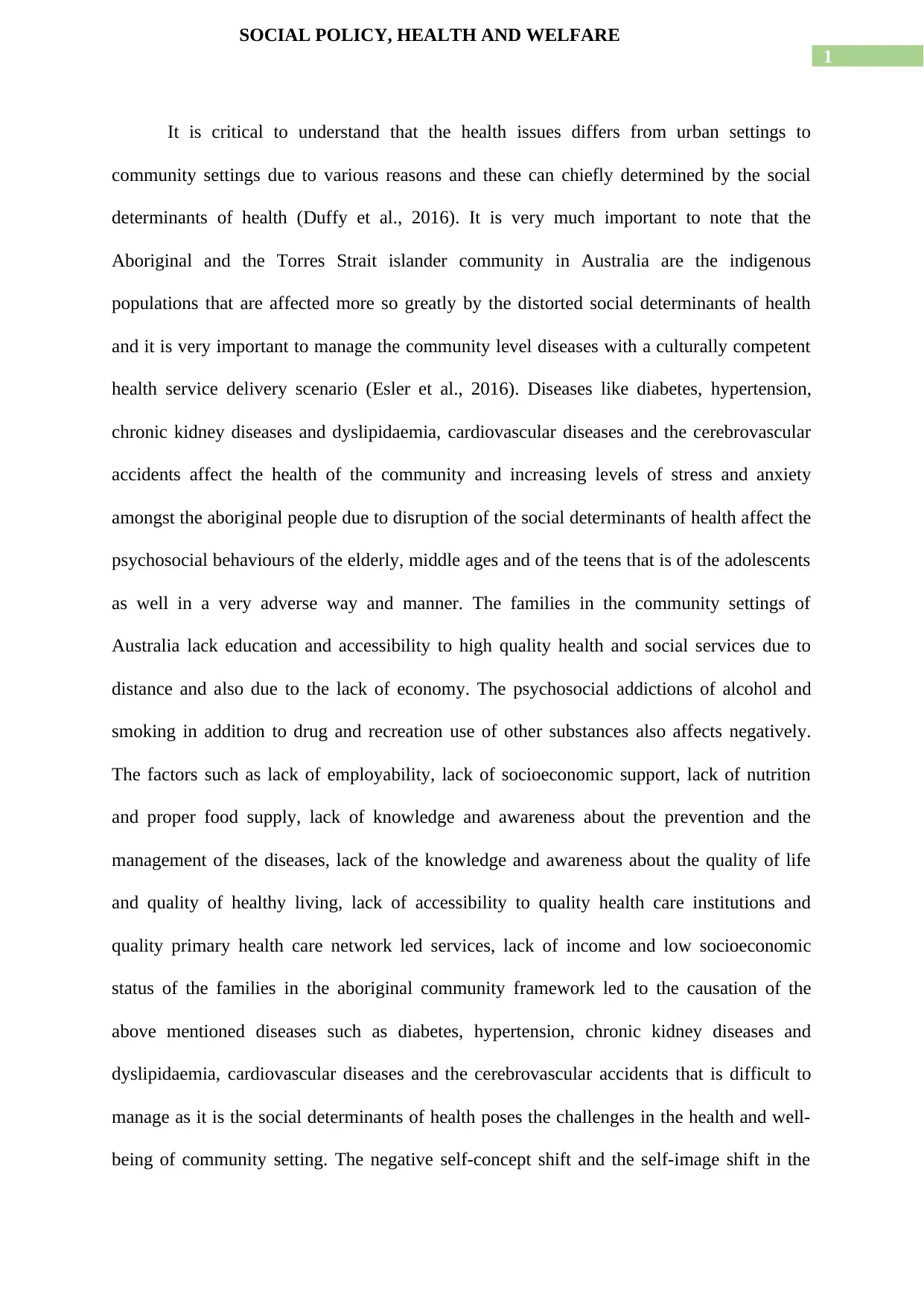
1
SOCIAL POLICY, HEALTH AND WELFARE
It is critical to understand that the health issues differs from urban settings to
community settings due to various reasons and these can chiefly determined by the social
determinants of health (Duffy et al., 2016). It is very much important to note that the
Aboriginal and the Torres Strait islander community in Australia are the indigenous
populations that are affected more so greatly by the distorted social determinants of health
and it is very important to manage the community level diseases with a culturally competent
health service delivery scenario (Esler et al., 2016). Diseases like diabetes, hypertension,
chronic kidney diseases and dyslipidaemia, cardiovascular diseases and the cerebrovascular
accidents affect the health of the community and increasing levels of stress and anxiety
amongst the aboriginal people due to disruption of the social determinants of health affect the
psychosocial behaviours of the elderly, middle ages and of the teens that is of the adolescents
as well in a very adverse way and manner. The families in the community settings of
Australia lack education and accessibility to high quality health and social services due to
distance and also due to the lack of economy. The psychosocial addictions of alcohol and
smoking in addition to drug and recreation use of other substances also affects negatively.
The factors such as lack of employability, lack of socioeconomic support, lack of nutrition
and proper food supply, lack of knowledge and awareness about the prevention and the
management of the diseases, lack of the knowledge and awareness about the quality of life
and quality of healthy living, lack of accessibility to quality health care institutions and
quality primary health care network led services, lack of income and low socioeconomic
status of the families in the aboriginal community framework led to the causation of the
above mentioned diseases such as diabetes, hypertension, chronic kidney diseases and
dyslipidaemia, cardiovascular diseases and the cerebrovascular accidents that is difficult to
manage as it is the social determinants of health poses the challenges in the health and well-
being of community setting. The negative self-concept shift and the self-image shift in the
SOCIAL POLICY, HEALTH AND WELFARE
It is critical to understand that the health issues differs from urban settings to
community settings due to various reasons and these can chiefly determined by the social
determinants of health (Duffy et al., 2016). It is very much important to note that the
Aboriginal and the Torres Strait islander community in Australia are the indigenous
populations that are affected more so greatly by the distorted social determinants of health
and it is very important to manage the community level diseases with a culturally competent
health service delivery scenario (Esler et al., 2016). Diseases like diabetes, hypertension,
chronic kidney diseases and dyslipidaemia, cardiovascular diseases and the cerebrovascular
accidents affect the health of the community and increasing levels of stress and anxiety
amongst the aboriginal people due to disruption of the social determinants of health affect the
psychosocial behaviours of the elderly, middle ages and of the teens that is of the adolescents
as well in a very adverse way and manner. The families in the community settings of
Australia lack education and accessibility to high quality health and social services due to
distance and also due to the lack of economy. The psychosocial addictions of alcohol and
smoking in addition to drug and recreation use of other substances also affects negatively.
The factors such as lack of employability, lack of socioeconomic support, lack of nutrition
and proper food supply, lack of knowledge and awareness about the prevention and the
management of the diseases, lack of the knowledge and awareness about the quality of life
and quality of healthy living, lack of accessibility to quality health care institutions and
quality primary health care network led services, lack of income and low socioeconomic
status of the families in the aboriginal community framework led to the causation of the
above mentioned diseases such as diabetes, hypertension, chronic kidney diseases and
dyslipidaemia, cardiovascular diseases and the cerebrovascular accidents that is difficult to
manage as it is the social determinants of health poses the challenges in the health and well-
being of community setting. The negative self-concept shift and the self-image shift in the
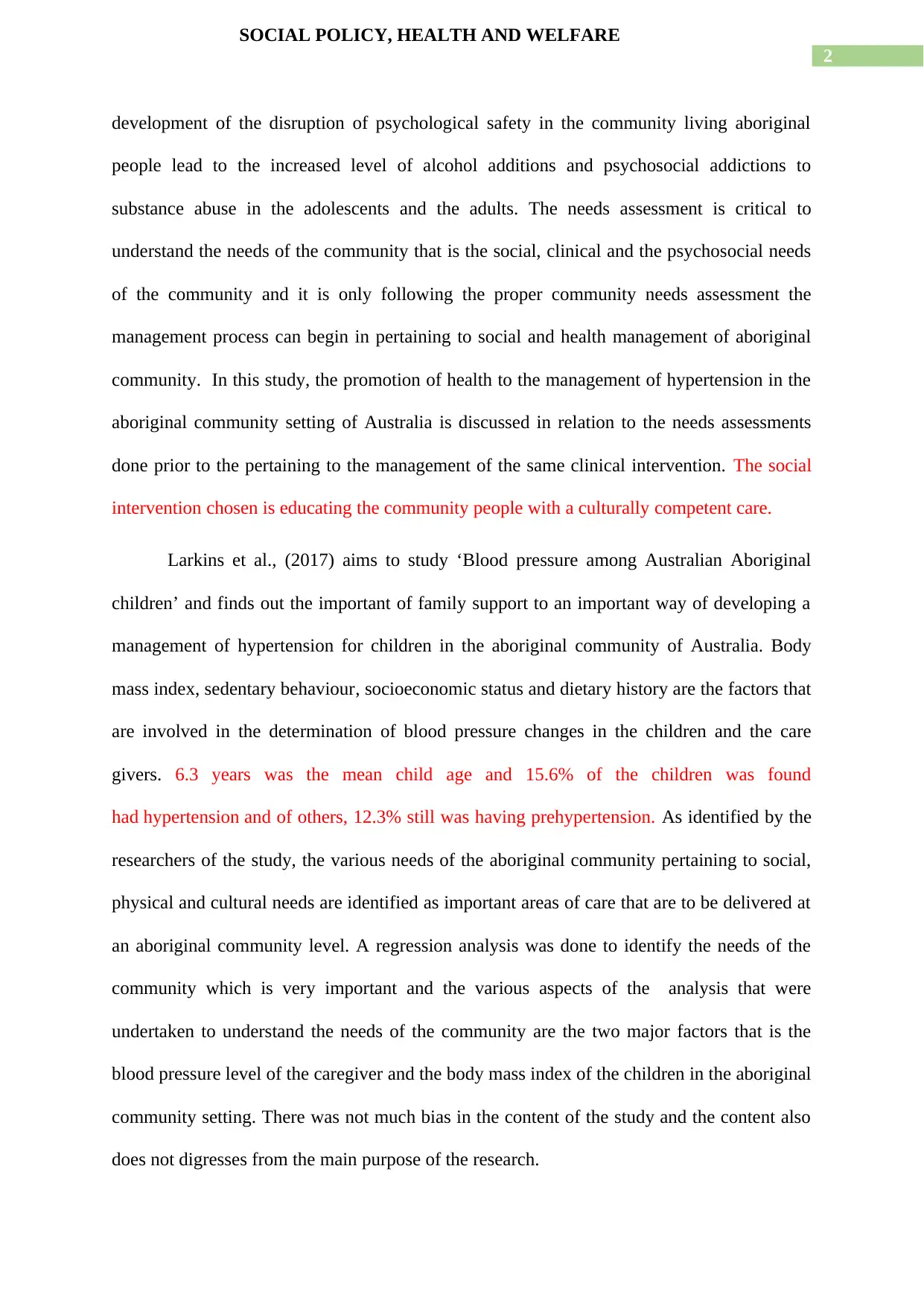
2
SOCIAL POLICY, HEALTH AND WELFARE
development of the disruption of psychological safety in the community living aboriginal
people lead to the increased level of alcohol additions and psychosocial addictions to
substance abuse in the adolescents and the adults. The needs assessment is critical to
understand the needs of the community that is the social, clinical and the psychosocial needs
of the community and it is only following the proper community needs assessment the
management process can begin in pertaining to social and health management of aboriginal
community. In this study, the promotion of health to the management of hypertension in the
aboriginal community setting of Australia is discussed in relation to the needs assessments
done prior to the pertaining to the management of the same clinical intervention. The social
intervention chosen is educating the community people with a culturally competent care.
Larkins et al., (2017) aims to study ‘Blood pressure among Australian Aboriginal
children’ and finds out the important of family support to an important way of developing a
management of hypertension for children in the aboriginal community of Australia. Body
mass index, sedentary behaviour, socioeconomic status and dietary history are the factors that
are involved in the determination of blood pressure changes in the children and the care
givers. 6.3 years was the mean child age and 15.6% of the children was found
had hypertension and of others, 12.3% still was having prehypertension. As identified by the
researchers of the study, the various needs of the aboriginal community pertaining to social,
physical and cultural needs are identified as important areas of care that are to be delivered at
an aboriginal community level. A regression analysis was done to identify the needs of the
community which is very important and the various aspects of the analysis that were
undertaken to understand the needs of the community are the two major factors that is the
blood pressure level of the caregiver and the body mass index of the children in the aboriginal
community setting. There was not much bias in the content of the study and the content also
does not digresses from the main purpose of the research.
SOCIAL POLICY, HEALTH AND WELFARE
development of the disruption of psychological safety in the community living aboriginal
people lead to the increased level of alcohol additions and psychosocial addictions to
substance abuse in the adolescents and the adults. The needs assessment is critical to
understand the needs of the community that is the social, clinical and the psychosocial needs
of the community and it is only following the proper community needs assessment the
management process can begin in pertaining to social and health management of aboriginal
community. In this study, the promotion of health to the management of hypertension in the
aboriginal community setting of Australia is discussed in relation to the needs assessments
done prior to the pertaining to the management of the same clinical intervention. The social
intervention chosen is educating the community people with a culturally competent care.
Larkins et al., (2017) aims to study ‘Blood pressure among Australian Aboriginal
children’ and finds out the important of family support to an important way of developing a
management of hypertension for children in the aboriginal community of Australia. Body
mass index, sedentary behaviour, socioeconomic status and dietary history are the factors that
are involved in the determination of blood pressure changes in the children and the care
givers. 6.3 years was the mean child age and 15.6% of the children was found
had hypertension and of others, 12.3% still was having prehypertension. As identified by the
researchers of the study, the various needs of the aboriginal community pertaining to social,
physical and cultural needs are identified as important areas of care that are to be delivered at
an aboriginal community level. A regression analysis was done to identify the needs of the
community which is very important and the various aspects of the analysis that were
undertaken to understand the needs of the community are the two major factors that is the
blood pressure level of the caregiver and the body mass index of the children in the aboriginal
community setting. There was not much bias in the content of the study and the content also
does not digresses from the main purpose of the research.
⊘ This is a preview!⊘
Do you want full access?
Subscribe today to unlock all pages.

Trusted by 1+ million students worldwide
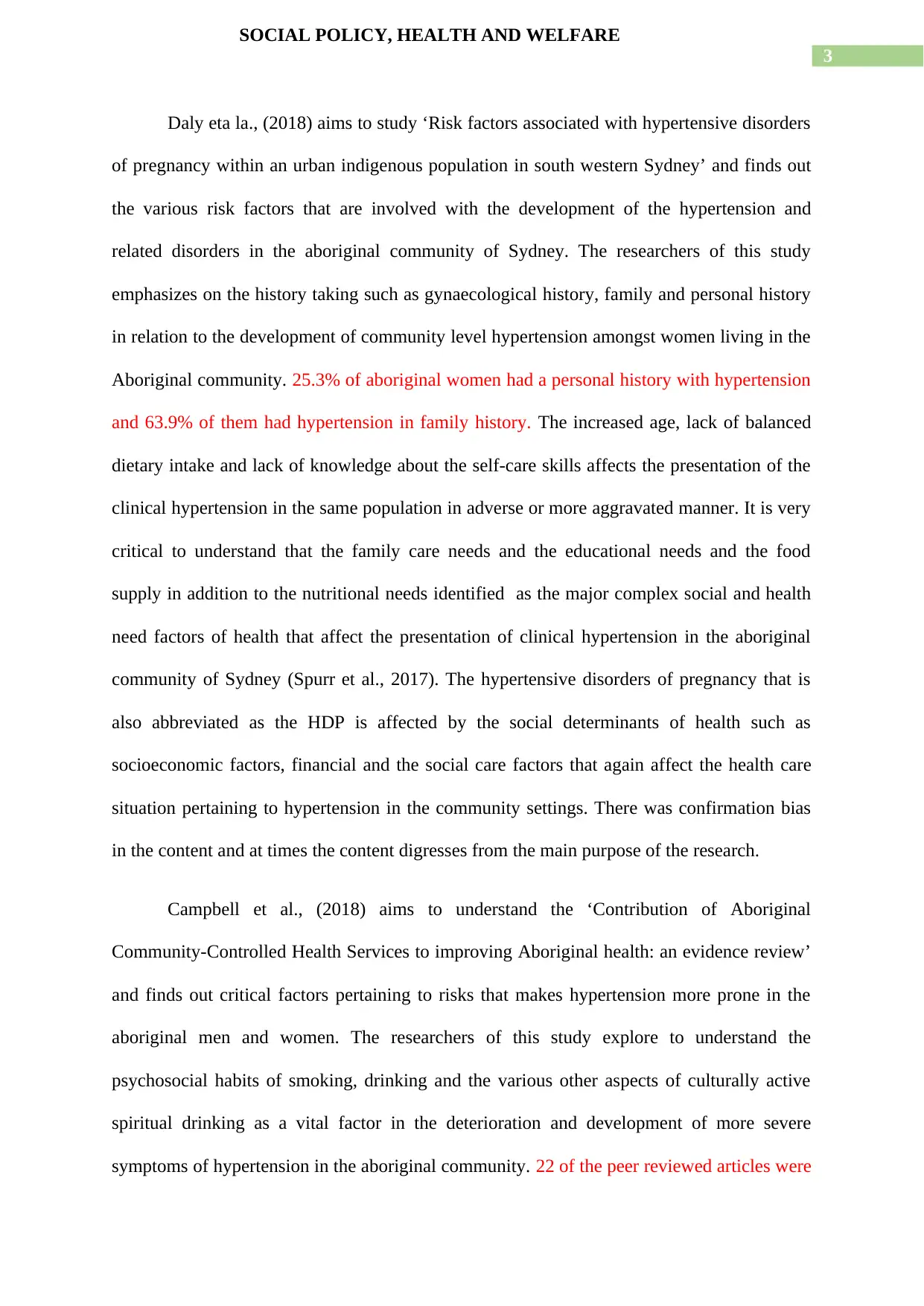
3
SOCIAL POLICY, HEALTH AND WELFARE
Daly eta la., (2018) aims to study ‘Risk factors associated with hypertensive disorders
of pregnancy within an urban indigenous population in south western Sydney’ and finds out
the various risk factors that are involved with the development of the hypertension and
related disorders in the aboriginal community of Sydney. The researchers of this study
emphasizes on the history taking such as gynaecological history, family and personal history
in relation to the development of community level hypertension amongst women living in the
Aboriginal community. 25.3% of aboriginal women had a personal history with hypertension
and 63.9% of them had hypertension in family history. The increased age, lack of balanced
dietary intake and lack of knowledge about the self-care skills affects the presentation of the
clinical hypertension in the same population in adverse or more aggravated manner. It is very
critical to understand that the family care needs and the educational needs and the food
supply in addition to the nutritional needs identified as the major complex social and health
need factors of health that affect the presentation of clinical hypertension in the aboriginal
community of Sydney (Spurr et al., 2017). The hypertensive disorders of pregnancy that is
also abbreviated as the HDP is affected by the social determinants of health such as
socioeconomic factors, financial and the social care factors that again affect the health care
situation pertaining to hypertension in the community settings. There was confirmation bias
in the content and at times the content digresses from the main purpose of the research.
Campbell et al., (2018) aims to understand the ‘Contribution of Aboriginal
Community-Controlled Health Services to improving Aboriginal health: an evidence review’
and finds out critical factors pertaining to risks that makes hypertension more prone in the
aboriginal men and women. The researchers of this study explore to understand the
psychosocial habits of smoking, drinking and the various other aspects of culturally active
spiritual drinking as a vital factor in the deterioration and development of more severe
symptoms of hypertension in the aboriginal community. 22 of the peer reviewed articles were
SOCIAL POLICY, HEALTH AND WELFARE
Daly eta la., (2018) aims to study ‘Risk factors associated with hypertensive disorders
of pregnancy within an urban indigenous population in south western Sydney’ and finds out
the various risk factors that are involved with the development of the hypertension and
related disorders in the aboriginal community of Sydney. The researchers of this study
emphasizes on the history taking such as gynaecological history, family and personal history
in relation to the development of community level hypertension amongst women living in the
Aboriginal community. 25.3% of aboriginal women had a personal history with hypertension
and 63.9% of them had hypertension in family history. The increased age, lack of balanced
dietary intake and lack of knowledge about the self-care skills affects the presentation of the
clinical hypertension in the same population in adverse or more aggravated manner. It is very
critical to understand that the family care needs and the educational needs and the food
supply in addition to the nutritional needs identified as the major complex social and health
need factors of health that affect the presentation of clinical hypertension in the aboriginal
community of Sydney (Spurr et al., 2017). The hypertensive disorders of pregnancy that is
also abbreviated as the HDP is affected by the social determinants of health such as
socioeconomic factors, financial and the social care factors that again affect the health care
situation pertaining to hypertension in the community settings. There was confirmation bias
in the content and at times the content digresses from the main purpose of the research.
Campbell et al., (2018) aims to understand the ‘Contribution of Aboriginal
Community-Controlled Health Services to improving Aboriginal health: an evidence review’
and finds out critical factors pertaining to risks that makes hypertension more prone in the
aboriginal men and women. The researchers of this study explore to understand the
psychosocial habits of smoking, drinking and the various other aspects of culturally active
spiritual drinking as a vital factor in the deterioration and development of more severe
symptoms of hypertension in the aboriginal community. 22 of the peer reviewed articles were
Paraphrase This Document
Need a fresh take? Get an instant paraphrase of this document with our AI Paraphraser
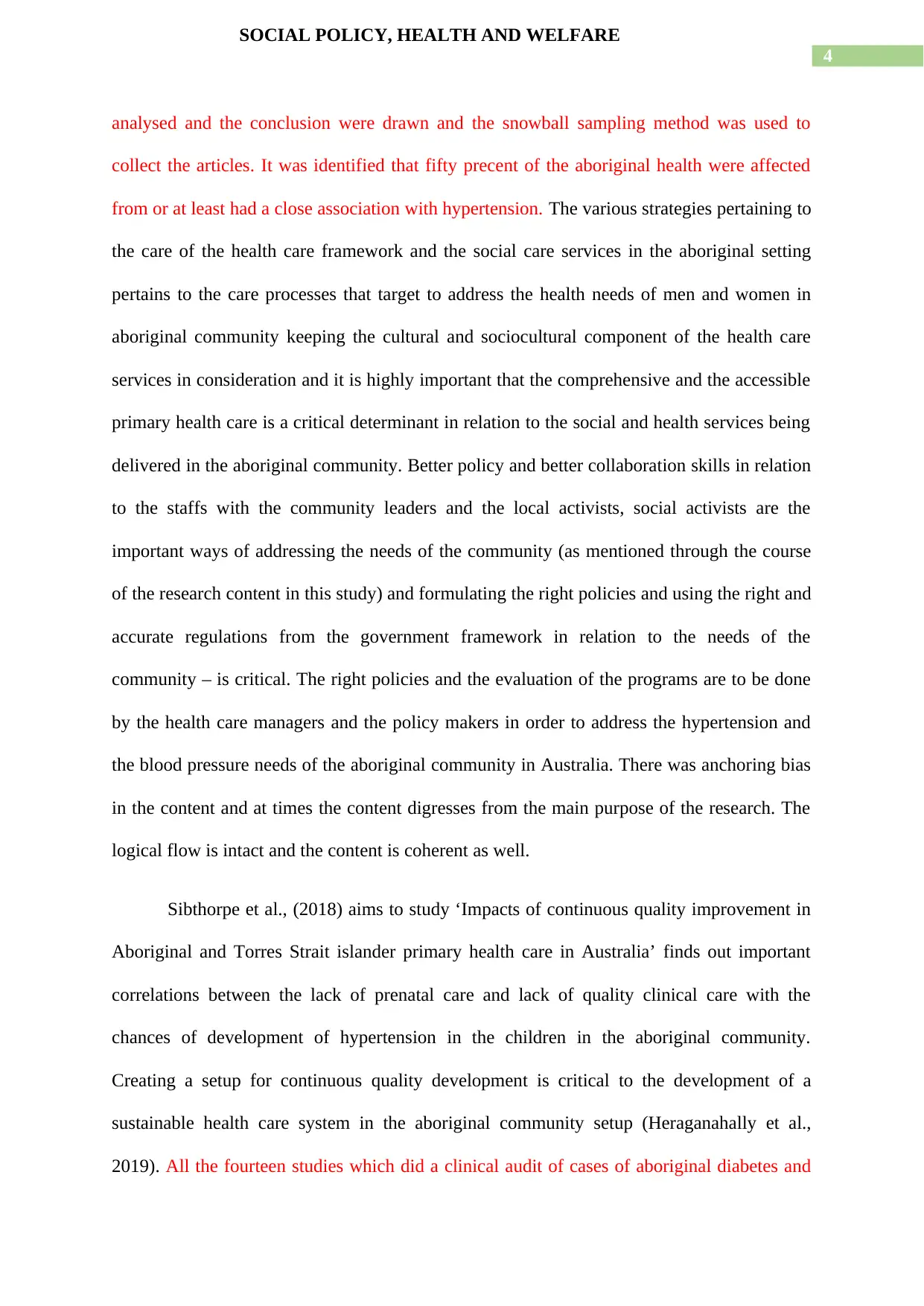
4
SOCIAL POLICY, HEALTH AND WELFARE
analysed and the conclusion were drawn and the snowball sampling method was used to
collect the articles. It was identified that fifty precent of the aboriginal health were affected
from or at least had a close association with hypertension. The various strategies pertaining to
the care of the health care framework and the social care services in the aboriginal setting
pertains to the care processes that target to address the health needs of men and women in
aboriginal community keeping the cultural and sociocultural component of the health care
services in consideration and it is highly important that the comprehensive and the accessible
primary health care is a critical determinant in relation to the social and health services being
delivered in the aboriginal community. Better policy and better collaboration skills in relation
to the staffs with the community leaders and the local activists, social activists are the
important ways of addressing the needs of the community (as mentioned through the course
of the research content in this study) and formulating the right policies and using the right and
accurate regulations from the government framework in relation to the needs of the
community – is critical. The right policies and the evaluation of the programs are to be done
by the health care managers and the policy makers in order to address the hypertension and
the blood pressure needs of the aboriginal community in Australia. There was anchoring bias
in the content and at times the content digresses from the main purpose of the research. The
logical flow is intact and the content is coherent as well.
Sibthorpe et al., (2018) aims to study ‘Impacts of continuous quality improvement in
Aboriginal and Torres Strait islander primary health care in Australia’ finds out important
correlations between the lack of prenatal care and lack of quality clinical care with the
chances of development of hypertension in the children in the aboriginal community.
Creating a setup for continuous quality development is critical to the development of a
sustainable health care system in the aboriginal community setup (Heraganahally et al.,
2019). All the fourteen studies which did a clinical audit of cases of aboriginal diabetes and
SOCIAL POLICY, HEALTH AND WELFARE
analysed and the conclusion were drawn and the snowball sampling method was used to
collect the articles. It was identified that fifty precent of the aboriginal health were affected
from or at least had a close association with hypertension. The various strategies pertaining to
the care of the health care framework and the social care services in the aboriginal setting
pertains to the care processes that target to address the health needs of men and women in
aboriginal community keeping the cultural and sociocultural component of the health care
services in consideration and it is highly important that the comprehensive and the accessible
primary health care is a critical determinant in relation to the social and health services being
delivered in the aboriginal community. Better policy and better collaboration skills in relation
to the staffs with the community leaders and the local activists, social activists are the
important ways of addressing the needs of the community (as mentioned through the course
of the research content in this study) and formulating the right policies and using the right and
accurate regulations from the government framework in relation to the needs of the
community – is critical. The right policies and the evaluation of the programs are to be done
by the health care managers and the policy makers in order to address the hypertension and
the blood pressure needs of the aboriginal community in Australia. There was anchoring bias
in the content and at times the content digresses from the main purpose of the research. The
logical flow is intact and the content is coherent as well.
Sibthorpe et al., (2018) aims to study ‘Impacts of continuous quality improvement in
Aboriginal and Torres Strait islander primary health care in Australia’ finds out important
correlations between the lack of prenatal care and lack of quality clinical care with the
chances of development of hypertension in the children in the aboriginal community.
Creating a setup for continuous quality development is critical to the development of a
sustainable health care system in the aboriginal community setup (Heraganahally et al.,
2019). All the fourteen studies which did a clinical audit of cases of aboriginal diabetes and
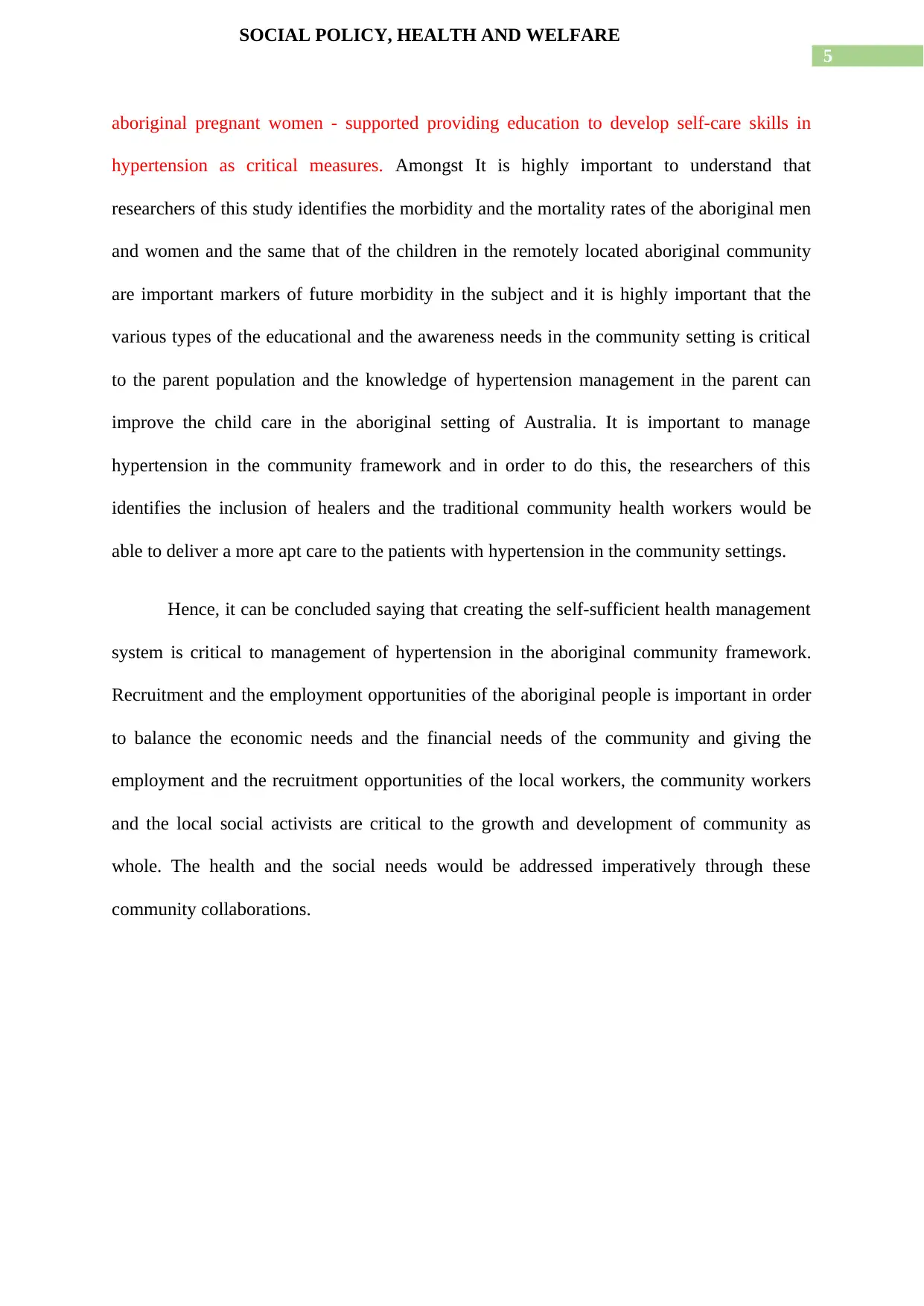
5
SOCIAL POLICY, HEALTH AND WELFARE
aboriginal pregnant women - supported providing education to develop self-care skills in
hypertension as critical measures. Amongst It is highly important to understand that
researchers of this study identifies the morbidity and the mortality rates of the aboriginal men
and women and the same that of the children in the remotely located aboriginal community
are important markers of future morbidity in the subject and it is highly important that the
various types of the educational and the awareness needs in the community setting is critical
to the parent population and the knowledge of hypertension management in the parent can
improve the child care in the aboriginal setting of Australia. It is important to manage
hypertension in the community framework and in order to do this, the researchers of this
identifies the inclusion of healers and the traditional community health workers would be
able to deliver a more apt care to the patients with hypertension in the community settings.
Hence, it can be concluded saying that creating the self-sufficient health management
system is critical to management of hypertension in the aboriginal community framework.
Recruitment and the employment opportunities of the aboriginal people is important in order
to balance the economic needs and the financial needs of the community and giving the
employment and the recruitment opportunities of the local workers, the community workers
and the local social activists are critical to the growth and development of community as
whole. The health and the social needs would be addressed imperatively through these
community collaborations.
SOCIAL POLICY, HEALTH AND WELFARE
aboriginal pregnant women - supported providing education to develop self-care skills in
hypertension as critical measures. Amongst It is highly important to understand that
researchers of this study identifies the morbidity and the mortality rates of the aboriginal men
and women and the same that of the children in the remotely located aboriginal community
are important markers of future morbidity in the subject and it is highly important that the
various types of the educational and the awareness needs in the community setting is critical
to the parent population and the knowledge of hypertension management in the parent can
improve the child care in the aboriginal setting of Australia. It is important to manage
hypertension in the community framework and in order to do this, the researchers of this
identifies the inclusion of healers and the traditional community health workers would be
able to deliver a more apt care to the patients with hypertension in the community settings.
Hence, it can be concluded saying that creating the self-sufficient health management
system is critical to management of hypertension in the aboriginal community framework.
Recruitment and the employment opportunities of the aboriginal people is important in order
to balance the economic needs and the financial needs of the community and giving the
employment and the recruitment opportunities of the local workers, the community workers
and the local social activists are critical to the growth and development of community as
whole. The health and the social needs would be addressed imperatively through these
community collaborations.
⊘ This is a preview!⊘
Do you want full access?
Subscribe today to unlock all pages.

Trusted by 1+ million students worldwide
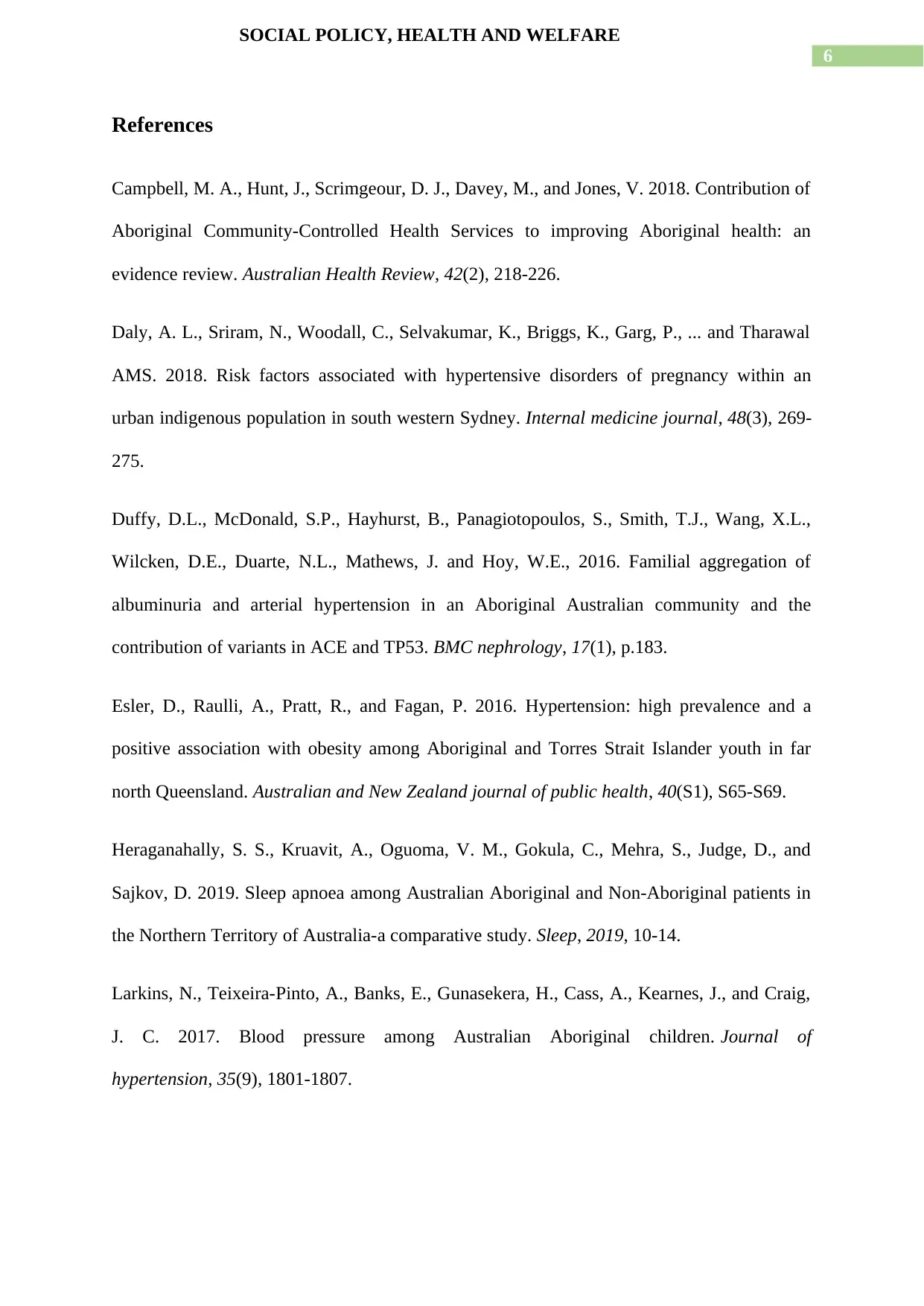
6
SOCIAL POLICY, HEALTH AND WELFARE
References
Campbell, M. A., Hunt, J., Scrimgeour, D. J., Davey, M., and Jones, V. 2018. Contribution of
Aboriginal Community-Controlled Health Services to improving Aboriginal health: an
evidence review. Australian Health Review, 42(2), 218-226.
Daly, A. L., Sriram, N., Woodall, C., Selvakumar, K., Briggs, K., Garg, P., ... and Tharawal
AMS. 2018. Risk factors associated with hypertensive disorders of pregnancy within an
urban indigenous population in south western Sydney. Internal medicine journal, 48(3), 269-
275.
Duffy, D.L., McDonald, S.P., Hayhurst, B., Panagiotopoulos, S., Smith, T.J., Wang, X.L.,
Wilcken, D.E., Duarte, N.L., Mathews, J. and Hoy, W.E., 2016. Familial aggregation of
albuminuria and arterial hypertension in an Aboriginal Australian community and the
contribution of variants in ACE and TP53. BMC nephrology, 17(1), p.183.
Esler, D., Raulli, A., Pratt, R., and Fagan, P. 2016. Hypertension: high prevalence and a
positive association with obesity among Aboriginal and Torres Strait Islander youth in far
north Queensland. Australian and New Zealand journal of public health, 40(S1), S65-S69.
Heraganahally, S. S., Kruavit, A., Oguoma, V. M., Gokula, C., Mehra, S., Judge, D., and
Sajkov, D. 2019. Sleep apnoea among Australian Aboriginal and Non-Aboriginal patients in
the Northern Territory of Australia-a comparative study. Sleep, 2019, 10-14.
Larkins, N., Teixeira-Pinto, A., Banks, E., Gunasekera, H., Cass, A., Kearnes, J., and Craig,
J. C. 2017. Blood pressure among Australian Aboriginal children. Journal of
hypertension, 35(9), 1801-1807.
SOCIAL POLICY, HEALTH AND WELFARE
References
Campbell, M. A., Hunt, J., Scrimgeour, D. J., Davey, M., and Jones, V. 2018. Contribution of
Aboriginal Community-Controlled Health Services to improving Aboriginal health: an
evidence review. Australian Health Review, 42(2), 218-226.
Daly, A. L., Sriram, N., Woodall, C., Selvakumar, K., Briggs, K., Garg, P., ... and Tharawal
AMS. 2018. Risk factors associated with hypertensive disorders of pregnancy within an
urban indigenous population in south western Sydney. Internal medicine journal, 48(3), 269-
275.
Duffy, D.L., McDonald, S.P., Hayhurst, B., Panagiotopoulos, S., Smith, T.J., Wang, X.L.,
Wilcken, D.E., Duarte, N.L., Mathews, J. and Hoy, W.E., 2016. Familial aggregation of
albuminuria and arterial hypertension in an Aboriginal Australian community and the
contribution of variants in ACE and TP53. BMC nephrology, 17(1), p.183.
Esler, D., Raulli, A., Pratt, R., and Fagan, P. 2016. Hypertension: high prevalence and a
positive association with obesity among Aboriginal and Torres Strait Islander youth in far
north Queensland. Australian and New Zealand journal of public health, 40(S1), S65-S69.
Heraganahally, S. S., Kruavit, A., Oguoma, V. M., Gokula, C., Mehra, S., Judge, D., and
Sajkov, D. 2019. Sleep apnoea among Australian Aboriginal and Non-Aboriginal patients in
the Northern Territory of Australia-a comparative study. Sleep, 2019, 10-14.
Larkins, N., Teixeira-Pinto, A., Banks, E., Gunasekera, H., Cass, A., Kearnes, J., and Craig,
J. C. 2017. Blood pressure among Australian Aboriginal children. Journal of
hypertension, 35(9), 1801-1807.
Paraphrase This Document
Need a fresh take? Get an instant paraphrase of this document with our AI Paraphraser
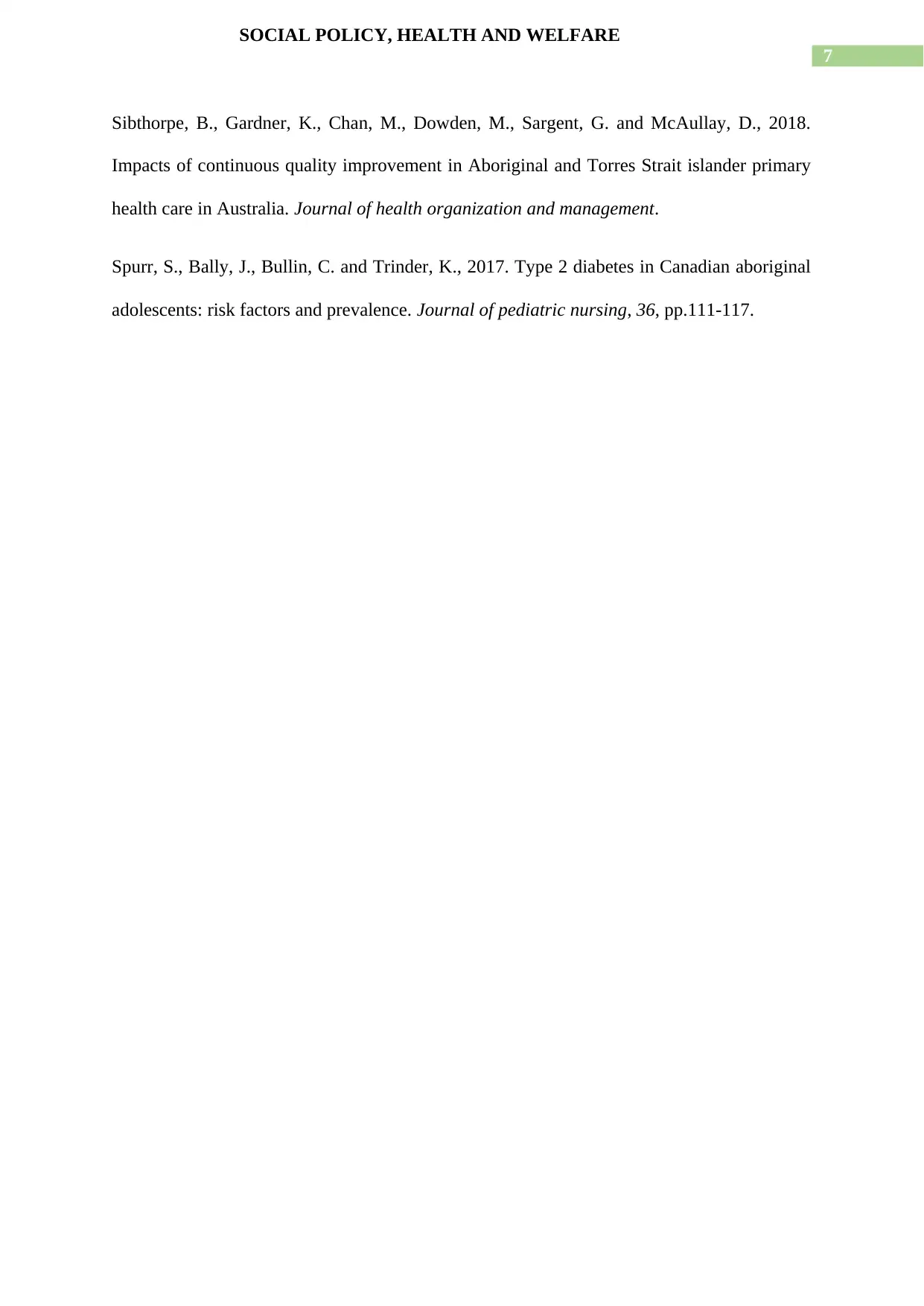
7
SOCIAL POLICY, HEALTH AND WELFARE
Sibthorpe, B., Gardner, K., Chan, M., Dowden, M., Sargent, G. and McAullay, D., 2018.
Impacts of continuous quality improvement in Aboriginal and Torres Strait islander primary
health care in Australia. Journal of health organization and management.
Spurr, S., Bally, J., Bullin, C. and Trinder, K., 2017. Type 2 diabetes in Canadian aboriginal
adolescents: risk factors and prevalence. Journal of pediatric nursing, 36, pp.111-117.
SOCIAL POLICY, HEALTH AND WELFARE
Sibthorpe, B., Gardner, K., Chan, M., Dowden, M., Sargent, G. and McAullay, D., 2018.
Impacts of continuous quality improvement in Aboriginal and Torres Strait islander primary
health care in Australia. Journal of health organization and management.
Spurr, S., Bally, J., Bullin, C. and Trinder, K., 2017. Type 2 diabetes in Canadian aboriginal
adolescents: risk factors and prevalence. Journal of pediatric nursing, 36, pp.111-117.
1 out of 8
Related Documents
Your All-in-One AI-Powered Toolkit for Academic Success.
+13062052269
info@desklib.com
Available 24*7 on WhatsApp / Email
![[object Object]](/_next/static/media/star-bottom.7253800d.svg)
Unlock your academic potential
Copyright © 2020–2025 A2Z Services. All Rights Reserved. Developed and managed by ZUCOL.





